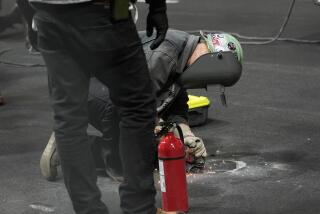Crash Response Criticized
- Share via
Driver Ralf Schumacher, who crashed violently Sunday in the United States Grand Prix at Indianapolis Motor Speedway, was back at his home in Salzburg, Austria, on Tuesday, recuperating from minor injuries, but the Federation Internationale de L’Automobile, the sanctioning body for Formula One, was taking heat over the accident.
It took emergency workers 1 minute 39 seconds to get to Schumacher, who received no direct physical assistance until Sydney Watkins, the FIA’s medical director, arrived 3 minutes 17 seconds after the crash.
“It was very frustrating to see Ralf there in his car for such a long time with no help,” said Willi Weber, Schumacher’s personal manager. “It seemed like endlessly until the doctor finally arrived.”
Derek Daly, a former Formula One driver serving as a pit reporter on the telecast of the race, was more outspoken.
” ... I don’t really care what the excuse was,” Daly said. “It should never be allowed to happen in the World Championship.... We’re talking drivers’ lives.
“If Schumacher’s car was on fire, he’d be dead now.”
Richard Woods, the FIA’s director of communications and official spokesman, defended the emergency procedure.
“We were satisfied with the response time,” he said from Paris. “We require medical personnel, including an expert in resuscitation, to arrive at an incident within two minutes. This was achieved.”
Schumacher, who drives for Williams BMW, was unable to exit the car on his own, but, Woods said, emergency workers first on the scene determined there was no need for resuscitation or emergency intervention, and waited for Watkins’ arrival.
Held overnight at an Indianapolis hospital, Schumacher, the younger brother of six-time champion Michael Schumacher, was released Monday with a bruised back and strained back muscles. He will miss testing this week in Spain and has two weeks to recover before the French Grand Prix.
A punctured tire threw Schumacher’s car into a spin at about 186 mph and it crashed backward into the concrete wall -- it missed the energy-absorbing SAFER barrier by about 25 feet -- in the final turn of the speedway’s road course configuration, the oval’s Turn 1.
Watkins was in an emergency vehicle at the end of pit road and had to navigate the entire 13-turn, 2.6-mile track before reaching Schumacher. “Maybe in situations like this, the medical staff should be allowed to drive against the correct direction to reach the driver,” Weber suggested. The FIA said it would have been too dangerous and “under the circumstances totally unnecessary” to drive against traffic down pit lane or on the front straight to reach Schumacher sooner.
“The safety car, medical car and the fast intervention cars were deployed by the FIA race director without delay, and the first car to reach the incident was the closest emergency vehicle,” Woods said. “All incidents are investigated in great detail via in-car accident data and circuit video footage as a matter of standard procedure. We do not feel that there was a problem which requires a remedy.”
Others weren’t so sure.
Said Terry Trammell, the orthopedic surgeon on duty in the infield hospital Sunday: “Everything that was supposed to happen happened. I just don’t know ... why it took so long to dispatch.” Dr. Steve Olvey, former director of medical affairs for Championship Auto Racing Teams, watched the race on TV and said it “seemed longer” than the 99 seconds it took for someone to reach Schumacher’s car. “But it always seems longer than it is,” he added.
Olvey said it was fortunate that Schumacher did not have an impaired air passage.
“If you have an [oxygen] airway problem after an accident, you have three, four minutes before you have irreversible brain damage,” he said. “If you have a bad injury with an airway problem, the head injury is made worse any time you’re without adequate oxygen.”
Speedway spokesman Ron Green said there were at least eight doctors stationed along the track who acted at the direction of the FIA.
The medical response teams, which also included FIA personnel, were the same teams used for other IMS events, the Indianapolis 500 for the Indy Racing League, and the Brickyard 400 for NASCAR.
“I know Professor Watkins real well, and I know he’s as frustrated as anyone,” Olvey said. “I know he’ll get to the bottom of why there was such a delay.”
Watkins, however, referred questions to the FIA.
More to Read
Go beyond the scoreboard
Get the latest on L.A.'s teams in the daily Sports Report newsletter.
You may occasionally receive promotional content from the Los Angeles Times.










